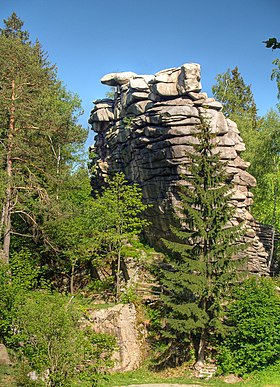Greifensteine
| Greifensteine | |
|---|---|

The Greifensteine rock tower near Ehrenfriedersdorf, Ore Mountains
|
|
| Highest point | |
| Elevation | 2,193 ft (668 m) |
| Coordinates | 50°38′56″N 12°55′49″E / 50.64889°N 12.93028°ECoordinates: 50°38′56″N 12°55′49″E / 50.64889°N 12.93028°E |
| Geography | |
| Location | Erzgebirge, Saxony, Germany |
| Parent range | Erzgebirge |
| Geology | |
| Age of rock | Tertiary |
| Mountain type | Granite |
The Greifensteine is a rock tower in the Ore Mountains, Germany, between the towns of Geyer, Ehrenfriedersdorf and Jahnsbach. The highest of the seven granite rocks reaches 731 m. Another six rock towers were demolished by quarrying, which ended in 1923.
Geologically, the Greifensteine is the top of a pluton. During the Variscan orogeny, magma intruded along structural zones, but cooled and solidified before reaching the earth surface. When the Erzgebirge block raised, the resulting granite formation raised with it. The surrounding softer material eroded and the harder granite remained, creating the tors of the rock formation. The deposition of ores associated with the intrusion gave the area its name (Erzgebirge, literally ore mountains).
Due to the productiveness of its ore deposits, the Greifensteine are also a well-known site of many different minerals and their varieties. As of 2014, a total of around 50 minerals and 10 varieties have been discovered here, including inter alia the well-known minerals andalusite, beryl, gypsum, haematite, muscovite, sphalerite, pyrite, topaz, wavellite and zircon, as well as various garnets, tourmalines, (dravite, elbaite, schorl) and wolframites. There are also rare minerals such as childrenite and natrodufrénite, as well as the radioactive minerals autunite and torbernite.
...
Wikipedia
